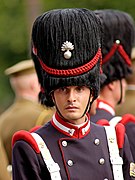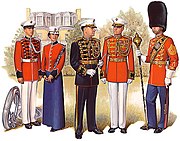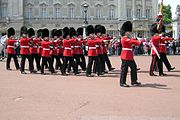Grenadier cap

The grenadier cap is a military headgear that was issued to grenadiers . The fusilier hat had a shape similar to the early grenadier hat . In the variant as a bearskin hat , it was given as an award to other elite and guard troops. The bearskin hat is still in use today in the parade uniforms of some parts of the guard.
Origins
The development of the grenadier cap began in the second half of the 17th century, when French infantrymen received special training as grenadiers in the standing army . The usual headgear of the soldiers of that time was a wide-brimmed hat ; However, this was not practical for the grenadiers for two reasons: On the one hand, the protruding hat was annoying when the soldier had to quickly hang the musket over his shoulder with the strap in order to switch to fighting with the grenades. In addition, the wide brim was a hindrance when swinging back to throw the grenade. Therefore, instead of hats, the grenadiers were prescribed the brimless pointed hat- like headgear, which was only worn by the rest of the troops for exercise .
Development in the 18th century

Since France held the political , military and cultural supremacy in Europe at the end of the 17th century , the French army was taken as a model by other states. Together with other elements, the grenadiers with their special headgear ended up in other armies, with the grenadier cap taking on very different shapes over the decades depending on the country. What all the variants had in common was that in the years after 1680 the originally soft hat was initially given a small, upright shield on the front. At this point the similarities ended and the various nation-specific developments began. Some examples:
- In France, the front shield was covered with black bearskin . Around 1720 the shield already encircled the entire head in a ring, whereby it was lower on the sides and back, but significantly higher over the forehead, so that the original tip of the cap was completely enclosed. By the end of the 18th century, the cap had not only grown considerably in height, the tip had also been reduced to an inconspicuous pouch. The development in Austria was similar .
- In Great Britain , the pointed cap was placed in front of a cloth-covered shield, which was embroidered with heraldic symbols and ornaments . As the shield got higher, the tip of the pouch was attached to its upper tip. After 1760 these hats were replaced by new ones made from bearskin. All companies of the British 1st Regiment of Foot Guards were allowed to wear bearskin hats by royal decree in 1815 for the fighting down of the French Guards Grenadiers at the Battle of Waterloo . The British Army later introduced them to all Guards Infantry Regiments.
- In Prussia , hats with an embroidered front shield were used, similar to those in England, until around 1730. Then a new type of hat was introduced, in which the shield was made of metal with embossed coats of arms and decorations. At first the shield was broken through and backed with colored cloth; later the metal surface was continuous. Grenadier caps were in use in this Frederickian form until the late 18th century.
In general it can be said that in the 18th century the choice of the grenadier hat type was related to political or denominational sympathies or dependencies. In the Holy Roman Empire, for example, caps with metal shields based on the Prussian model were found mainly in Protestant and Prussian-related states, while the armies of Catholic or Austrian-facing states mostly wore grenadier caps made of bearskin. In the Electorate of Hanover , which was linked to England through a personal union, hats based on the British model were used from 1786 onwards. The confessional distinction disappeared in the 18th century, and purely fashionable motifs were increasingly in the foreground. The British grenadiers initially wielded the “Protestant” miter. The first record of the use of bearskin hats dates back to 1768.
During the War of the Austrian Succession, grenadiers in the Saxon Army wore fusilier hat- style headgear, but when Saxon troops were re-established , initially under French pay , they were given bearskin hats with a French-style shield in 1761.
Even after the use of grenades disappeared in the mid-18th century, the hats for the elite units remained. It is not known why the bearskin hat prevailed among grenadiers in Catholic areas. Grenadier caps had lost their original purpose since the beginning of the 18th century, as thrown grenades were rarely used in combat. However, the caps were retained as they had already become an established symbol of elite troops.
Development in the 19th century
In Prussia, the grenadier cap , which was expensive to manufacture and impractical because of its height, was abolished in 1787 and replaced by the casket as a unitary headgear for the infantry. In 1799, however, the grenadiers again received special hats, which differed considerably from the previous models. Its high front shield, covered with black wool all around the edge, was made of black leather with a brass grenade attached as a badge ; the lower third of the shield was occupied by a brass plate with the Prussian eagle. In contrast to the classic grenadier hats, later versions of the new type also had a visor. This new model was considered aesthetically unsatisfactory and costly. When the uniform of the Prussian army was reformed after 1807 , the grenadier cap was dropped. It was not reintroduced to the Grenadiers of the Guard for representative occasions until the 1820s , initially with hats of the Russian model. It was only later that historical Frederickian hats were also issued and worn until 1918.
Under French influence, some armies of the Confederation of the Rhine used bearskin hats for grenadiers, sappers and guards. The Royal Bavarian Infantry Body Regiment led the grenadier cap from 1814 to 1826, the Grand Ducal Mecklenburg Grenadier Regiment No. 89 from 1821 to 1840. In the latter, the Leibcompanie kept the hat until 1918.
In France, the bearskin hat was retained after the French Revolution and the end of the Ancien Régime . Once again enlarged, it became the typical distinguishing feature of the grenadiers in Napoléon's Guard . In the Second Empire the bearskin hat was reintroduced as it was understood as a symbol of Napoléon Bonaparte's military successes. The heavy hats, which were uncomfortable to wear, especially in summer, were not very popular with soldiers. In the Sardinian War , countless grenadier caps were "lost" during the campaign , which means nothing other than that they were thrown away by the soldiers. After the Battle of Solferino in 1859, the French army finally abolished grenadier caps.
In Great Britain the Füselierregiments ( The Royal Fusiliers (City of London Regiment) , Royal Scots Fusiliers , Royal Welch Fusiliers and others) received fur hats in the course of the 19th century. While the officer's hats were made of bear skin, the hats of the teams were made of raccoon skin .
Development in the 20th / 21st Century and current use
The bearskin hat has only been worn by guard units on official occasions since the 20th century. The following units are still wearing bearskin hats at the beginning of the 21st century:
Australia
In the 3rd Battalion, Royal Australian Regiment , drummers wear grenadier hats.
Belgium
The Belgian police provide a mounted escort with grenadier hats for public appearances by members of the royal family ( Escorte Royale Belge - Het Koninklijk Escorte )
Denmark
Great Britain
In Great Britain, the bearskin grenadier cap was never completely abandoned, although it has long been no longer part of the uniform worn in battle. Today their use is limited to representative and ceremonial occasions, such as the Trooping the Color or the changing of the guard at Buckingham Palace and St James's Palace . The British Guards Infantry's grenadier cap is 18 inches (45.72 cm) high and weighs 1.5 pounds (680 g). To distinguish them, the regiments wear them with different colored and differently designed plumes or hair bushes, the stutz . With Stutz, the hat was especially worn in the late 18th century and in the first half of the 19th century. The fur prices at the London tobacco sales rose sharply every time the British Army Administration placed orders for new hats. About 100 bear skins of the American black bear are used annually for the hats . These come from support programs for the Canadian Inuit . Some of the hats that are still in use are over 100 years old. In the 1980s and 1990s, due to protests by animal rights activists, attempts were made to make the hats from synthetic material ( woven fur ) in the future . However, the new material differed from the historical hats, was less resistant to the effects of the weather and led to static charges that impaired wearing comfort. In 2008, before a major renovation, it was proposed to change the shape of the hats in order to be able to use other materials, but this did not materialize. In 2012, for reasons of religious freedom , a Sikh from the Scots Guards was allowed to wear the religious turban instead of the grenadier cap for guard duty.
The five regiments differ in the truss carried on the side:
- Coldstream Guards (red stub right side)
- Grenadier Guards (white stutz left side)
- Scots Guards (no Stutz)
- Irish Guards (blue trim right side)
- Welsh Guards (white / green / white stutz left side)
In addition, the grenadier cap is worn by some military musicians, e.g. B. with the musicians of the Honorable Artillery Company .
Italy
Canada
The following regiments wear the grenadier cap with their parade uniform:
- Royal 22e Regiment
- Governor General's Foot Guards
- Canadian Grenadier Guards
In addition, the grenadier cap is worn by some military musicians, e.g. B. with the musicians of The Royal Regiment of Canada .
Netherlands
- Guards regiment Grenadiers en Jagers
Sweden
United States
Drum majors of the US armed forces wear a grenadier cap with the following music corps:
- Army Field Band
- United States Army Band
- United States Air Force Band
- United States Coast Guard Band
- United States Marine Band (The President's Own)
- United States Marine Drum and Bugle Corps (The Commandant's Own)
- United States Navy Band
photos
Queen's Guard marches from Buckingham Palace to St James's Palace (Great Britain)
Den Kongelige Livgarde , Amalienborg , Copenhagen in summer gear (Denmark)
See also
literature
-
Richard Knötel , Herbert Knötel, Herbert Sieg: Colored Manual of Uniform Studies. The development of the military costume until 1937.
- Volume 1: The German States, Austria-Hungary and Switzerland New edition, Weltbild, Augsburg 1994.
- Volume 2: The European and non-European countries with the exception of the armed forces of the German states, Austria-Hungary and Switzerland dealt with in Volume 1. New edition, Spemann, Stuttgart 1994.
-
Liliane and Fred Funcken , historical uniforms :
- Volume 1, 18th Century, French Guard and Line Infantry, British and Prussian Infantry. Mosaik-Verlag, Munich 1977, ISBN 3-570-04361-4 .
- Volume 2, 18th Century, French, British and Prussian Cavalry and Artillery, Infantry, Cavalry and Artillery of the Remaining European Countries. Mosaik-Verlag, Munich 1978, ISBN 3-570-01865-2 .
- Volume 3, Napoleonic times, 1st French regiments of the line, British, Prussian and Spanish troops from the time of the First Empire. Mosaik-Verlag, Munich 1978, ISBN 3-570-06389-5 .
- Volume 4, Napoleonic Era, 2nd French Imperial Guards, the Allied troops, the Swedish, Austrian and Russian armies at the time of the First Empire. Mosaik-Verlag, Munich 1979, ISBN 3-570-05449-7 .
- Volume 5, 19th Century, 1814-1850: France, Great Britain, Prussia. Infantry, cavalry, technical troops and artillery. Mosaik-Verlag, Munich 1982, ISBN 3-570-04961-2 .
- Volume 6, 19th Century, 1850-1900: France, Great Britain, Germany, Austria, Russia. Infantry, cavalry, technical troops, artillery. Mosaik-Verlag, Munich 1983, ISBN 3-570-01461-4 .
Individual evidence
- ↑ Baran: Fur hats in the British Army . In Das Pelzgewerbe , Volume XVIII, 1967, No. 2, Hermelin-Verlag Dr. Paul Schöps, Berlin / Frankfurt / Leipzig / Vienna, p. 68.
- ↑ Zeitschrift für Heereskunde, 2001, p. 399ff.
- ↑ Paul Schöps in connection with Kurt Häse and Richard König sen. : The bears . In Das Pelzgewerbe , Volume XIII, 1967, No. 2, Hermelin-Verlag Dr. Paul Schöps, Berlin / Frankfurt / Leipzig / Vienna, p. 59.
- ↑ a b c d Johannes Leithäuser: Tierschützer - Der Garde ans Fell ( Page no longer available , search in web archives ) Info: The link was automatically marked as defective. Please check the link according to the instructions and then remove this notice. . In: FAZ , September 2, 2008
- ↑ Premiere in front of Buckingham Palace: Turban instead of bearskin hat , SPON from December 12, 2012









